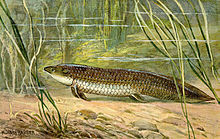Ceratodontidae is an extinct family of lungfish with fossils known worldwide from the earliest Triassic to the Eocene.
| Ceratodontidae Temporal range:
| |
|---|---|

| |
| Ceratodus | |
| Scientific classification | |
| Domain: | Eukaryota |
| Kingdom: | Animalia |
| Phylum: | Chordata |
| Clade: | Sarcopterygii |
| Class: | Dipnoi |
| Order: | Ceratodontiformes |
| Family: | †Ceratodontidae Gill, 1872 |
| Genera | |
|
See text | |
Taxonomy edit
Although the extant Queensland lungfish was formerly also classified in this family due to its similar appearance, phylogenetic and morphological evidence indicates that it belongs in a different family, Neoceratodontidae. A morphological study by Kemp et al (2017) proposed that Ceratodontidae was more closely related to modern African (Protopteridae) and South American lungfish (Leptosirenidae) than Queensland lungfish.[1] However, Brownstein, Harrington & Near (2023) found Ceratodontidae to lie outside the crown group of modern lungfish, with all modern lungfish more closely related to each other than to Ceratodontidae.[2]
Genera edit
The following genera are known from the family:[3]
- †Arganodus (alternatively placed in own family, Arganodontidae)
- †Ariguna
- †Ceratodus
- †Epiceratodus
- †Lupaceratodus Galula Formation, Tanzania, Cretaceous
- †Metaceratodus
- †Microceratodus (?)
- †Potamoceratodus
- †Tellerodus
- †Retodus
Paraceratodus was also classified in this family but phylogenetic evidence supports it being the most basal member of Ceratodontoidei.[1][4]
References edit
- ^ a b Kemp, Anne; Cavin, Lionel; Guinot, Guillaume (2017-04-01). "Evolutionary history of lungfishes with a new phylogeny of post-Devonian genera". Palaeogeography, Palaeoclimatology, Palaeoecology. 471: 209–219. Bibcode:2017PPP...471..209K. doi:10.1016/j.palaeo.2016.12.051. ISSN 0031-0182.
- ^ Brownstein, Chase Doran; Harrington, Richard C; Near, Thomas J. (July 2023). "The biogeography of extant lungfishes traces the breakup of Gondwana". Journal of Biogeography. 50 (7): 1191–1198. Bibcode:2023JBiog..50.1191B. doi:10.1111/jbi.14609. ISSN 0305-0270.
- ^ "Fossilworks: Ceratodontidae". fossilworks.org. Retrieved 17 December 2021.
- ^ "Fossilworks: Paraceratodus". fossilworks.org. Retrieved 17 December 2021.